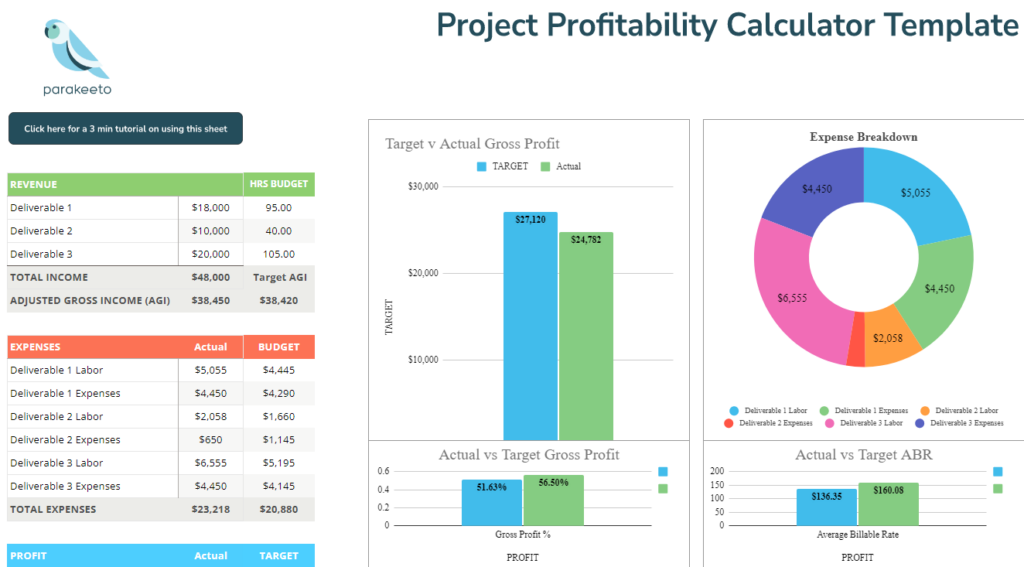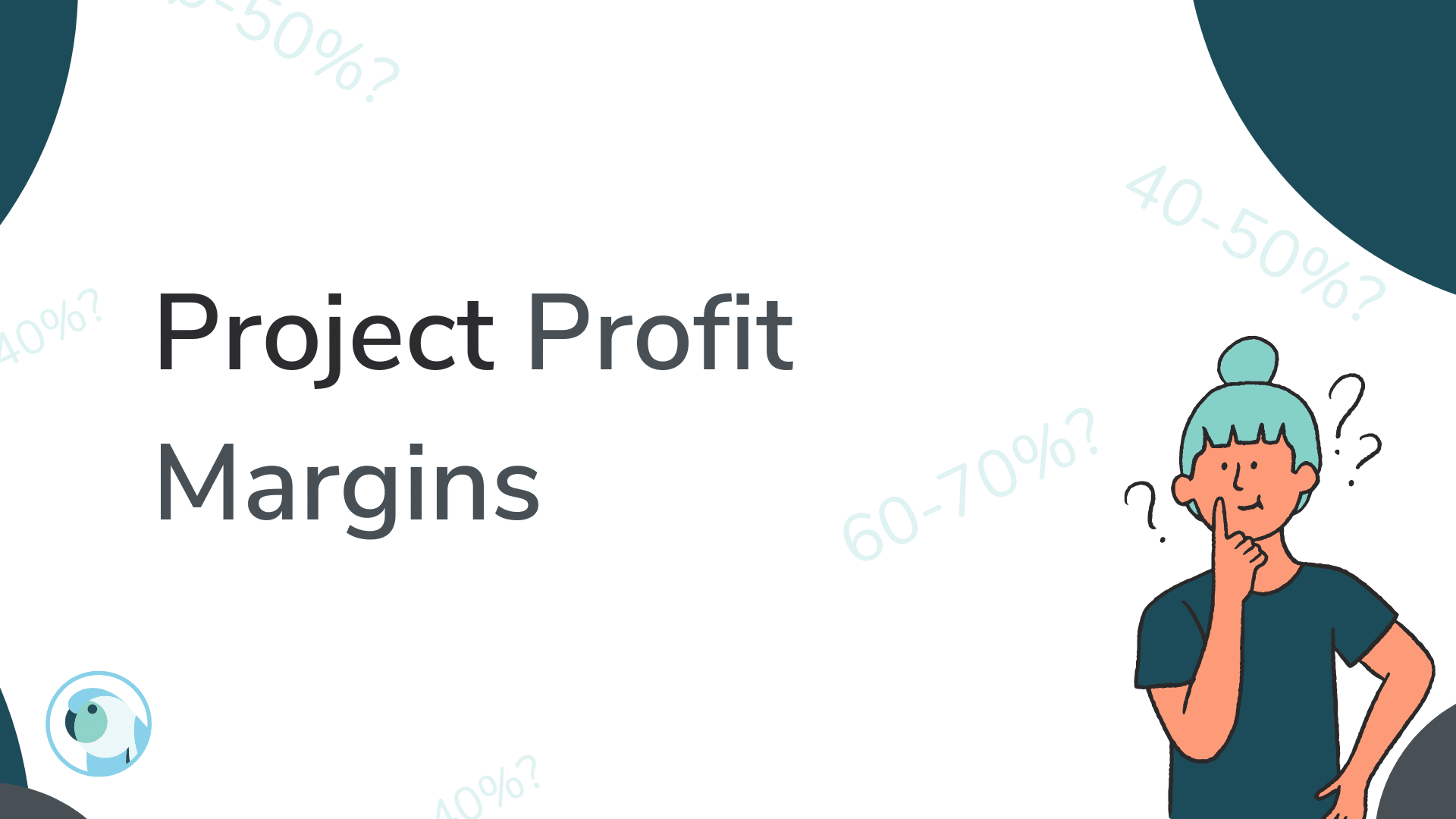If you’ve found your way to this post, you’re probably in search of one thing – an accurate view of your profit margin!
Should this be the case, a few questions could be floating around your head, including…
- How precise should I be when calculating my agency’s profit margins?
- What is and isn’t included in the formula for my profit margins?
- What do I do about this specific edge case?
As a whole, trying to calculate your profit margin on projects – and on an agency level – can get overwhelming. For example, what do you do about overhead costs? Should they be included in your calculations for project-level calculations? Additionally, what if you’re looking to compare one project to another – but one is a recurring ongoing project, while the other is a one-off? Here’s another; how do you handle other income, or pass-through expenses, for external vendors?!
Fret not, you’re in the right place. You’ll also be relieved to hear that calculating this number is much more simple than you might think. But first…
What is Project Profit Margin?
At its core, a profit margin measures the difference between the cost basis and income for a particular period of time, and/or subsection, of a business. It’s often used to measure the effectiveness of the business as a whole, or in a particular area, and measure how that margin trends over time.
Looking at profit margins on a project-basis allows us to compare projects, or types of work, to each other, thus identifying opportunities to drive more overall profit for the agency.
Importance of Individually Tracking the Profit of Each Project
What we’ve seen time and again while helping countless agencies fix profitability issues, is this: most agencies don’t need more work (higher sales). Rather, they merely need a higher quality delivery of said work. It’s like comparing starvation (that being zero work) to indigestion (work that isn’t nearly as profitable as it should be). Many of our clients have actually had projects that were costing them more money than they were bringing in when we ran these calculations for them.
Often, there is a small number of clients, project or service offerings that are subsidizing the agency, while a number of other clients/projects are costing the business money.
Becoming aware of profit margins on clients and projects can help you to identify the things that generate the most money while seeing opportunities to remove/replace revenue that is actually hurting the profitability of the company.
The good news? As a result, often profit margins are improved without having to grow the team or the cost-basis in the business. So, let’s get you started on the inputs to make this calculation!
Why Net-Profit Per-Project is a Fundamentally Flawed Concept
*Trigger Warning: Net Profit on a project is NOT a real thing. You’re wasting your time if you’re trying to measure it today.
Now that I’ve made a wildly polarizing statement to get your attention, allow me to backpedal a tad to what is more of an informed and pragmatic position…
Firstly, I want to make it clear that I’m not saying we should ignore the bottom line when measuring the profitability of a project, or indeed forget about our overhead costs. Rather, I’m saying we’re lying to ourselves if we think being precise about overhead costs at the project level is doing anything to improve the insight we’re getting at the project margin level. In fact, mixing the ever-changing cost of overhead and even things like the cost of fluctuations in utilization into our project-level margin calculations significantly degrades the level of insight we get from the calculation.
Think about it… overhead costs aren’t consistent from one project to another and don’t fluctuate in lock-step with the amount of revenue coming into the business. By including them at the project level, we could fool ourselves into thinking our projects are becoming more or less profitable when the fundamental profitability of that work hasn’t changed – only our fiscal management of the business has.
This means we can’t compare one project to another, or even one time period to another. We can’t gain any reliable insights into how our margins improve over time. It’s truly a trap of conflating the pursuit of precision with improvements in accuracy.
In this case, the precision comes at the cost of accuracy, and not the other way around.
The Delivery Margin First Approach
For this reason, it’s critical to start with measuring Delivery Margin (you might call this Gross Margin, or Contribution Margin) on a project level before pursuing a profit margin measurement that is closer to the bottom line.
In doing so, we allow ourselves to create a clear separation of how profitable the work is as opposed to how profitable the business is. This improves our ability to see where things are going better (or worse) than expected. Tracking the profitability of our work over time ultimately focuses our efforts on the correct things in order to improve the overall profitability of the business.
It also dramatically decreases the cost and complexity of measuring profitability at the project/client level – while still giving us the ability to pursue more granular profitability metrics as a secondary insight.
Performing a Project Profit Margin Calculation
Input 1: Agency Gross Income (AGI)
Agency Gross Income (AGI) represents the “true” income your agency is earning. This is via work that you perform and removes revenue that passes through your agency to other vendors – such as white label partners, external contractors, advertising spend, print budgets, materials, etc. Hence why these are referred to as ‘pass-through expenses.’
For example, let’s imagine you’ve just sold a website design & development project:
- The total fee for the website is $15,000
- You’ll be outsourcing the development, which will cost you $5,000
Therefore, your revenue on this project would be $15,000, whereas your Agency Gross Income (AGI) would be $10,000 (that being $15,000 minus the revenue that passes through your agency, to another vendor)
Measuring AGI, and using it as the basis for your profitability calculation, is critically important. Why? Well, it allows you to isolate the true revenue your business is responsible for earning with its operations. Therefore, your profit margin is helping you measure how efficiently your business earns that revenue.
It also helps ensure you’re making decisions based on the true size of your agency’s revenue – and not on an inflated number that isn’t reflective of the resources you actually have at your disposal.
The calculation for AGI is:
Revenue – Pass-through Expenses
To be clear… Pass-through Expenses are defined as costs for external vendors required to deliver work to end clients. This covers revenue that doesn’t “belong” to the agency, but rather passes through to an external vendor or partner. In addition to the examples provided above, it generally includes contractor fees for work outside of the core business of the agency (a video production company, for example), but not contract-based resources for flexible staffing involved in core services. If you apply a markup to those pass-through expenses, it will be reflected in your AGI. Only the expenses are subtracted in this calculation.
Input 2: Delivery Costs
The second critical input to calculating your profit margins is your Delivery Costs. These are the costs you incur in order to earn your revenue. The bulk of your Delivery Costs will be labor on the particular project or set of projects, you’re undertaking. There is a lot of confusion about how to properly calculate the delivery cost for any given amount of work.
The formula for Delivery Costs: Delivery Cost = Hours x Cost Per Hour (CPH)
There are various levels of abstraction that can be applied to Cost Per Hour depending on how precise you’d like to make this calculation. You can use an Average Cost Per Hour (ACPH) for a quick and directionally accurate measure of your margins by averaging the cost for a given set of team members. This is particularly useful when there aren’t significant differences in their costs or the number of hours they each contribute to a given project.
Calculating delivery costs for each individual employee, and then adding them up, may be necessary where there are material differences in the time each employee contributes to the project. The same can be said when their cost basis is materially different.
To get an in-depth understanding of how to calculate Cost-Per-Hour for an employee, plus also use our handy calculator, do check out this post.
In short, the formula for ACPH is: Employee’s Annual Cost / Employees Hours Per Year
This applies where the Employee’s Annual Cost is their annual salary + benefits (alongside other commissions) and the hours per year is gross hours worked on an annual basis. This is usually 2080 (40*52).
Example:
You’ve got a team member that has a fully loaded cost of 100k/year. Their contract accounts for 2080 hours of capacity per year.
Their cost per hour is $100,000 / 2080 = an ACPH of $48.
If this person spends 100 hours working on a project, their Delivery Costs add up to $48 x 100 = $4800
Formula for Calculating Delivery Profit Margin for a Project
Project Delivery Margin = (AGI – Delivery Costs) / AGI
This formula can apply to a single project or a group of projects. It can also be used to look at clients, departments, products, service lines, and any other subsection of the business.
Building on the last two examples: We’ve sold a website project for $15,000. We have $5,000 in pass-through expenses for development, plus $4,800 in delivery costs for the time it takes our team to complete the project.
Therefore, our Delivery Margin is the following: $10,000 – $4,800) / $10,000 = 52%
In this case, our delivery profit was $5,200, which is 52% of the $10,000 in Agency Gross Income we were responsible for earning on this project. Another viewpoint is that it cost us $0.48 to earn every dollar that belonged to us in this contract – so you have $0.52 left over to pay for overhead, and make a profit.
As you can see, this is an incredibly useful metric for comparing projects, clients, and departments to each other across any given time period. It is the purest form of measurement when it comes to understanding the fundamental profitability of a subsection of work in your agency while identifying what work is contributing the most to your agency’s profitability.
Formula for Calculating Net Profit Margin for a Project
Once you’ve isolated and calculated delivery margin – you can then go as crazy as you want trying to tie that back to net profit! This exercise is ultimately useful for setting delivery margin targets that allow you to get a relative sense of whether said margin is healthy or not – and how likely it is to be meaningfully contributing to the bottom line.
It’s important to keep in mind that the pursuit of precision rarely comes with equivalent improvements in accuracy. So, I strongly encourage you to keep things simple at this level. Apply some broad strokes to make your life easier.
The simplest way to do this is to use a percentage of AGI that is typically allocated to overhead spending, while using an inefficiency percentage to account for holidays, time off, and non-billable time. Then you subtract them from your delivery margin to arrive at a directionally accurate measure of the net profit contributed by a given project, or other subsection of work.
For most agencies, that overhead spending percentage will be around 20-30% and the inefficiency percentage will be 10-20%. You can get as sophisticated as you’d like in terms of how precise the calculations for % of AGI attributed to each of those areas become, and how frequently you update them.
The beautiful thing about doing it after the fact is that no amount of complexity at this level will add cost to your delivery margin formula. This provides you with a consistent foundation for measuring profitability that remains easy, inexpensive, and extremely insightful at all times.
For example:
- Our Delivery Margin on this project: 52%
- Our overhead percentage: 30%
- Our “Inefficiency” percentage: 15%
Estimated “Net profit” driven by this project = 52% – (30% + 20%) = 7%
As you can see from this calculation, we generally want to set the delivery margin target on a per-project basis to be 10-20% higher than the target on the P&L to account for inefficiency. So, if we’re trying to hit a 20% Net Profit as an agency this year, and we know we’ll spend around 30% of AGI on overhead, we want to be targeting about 60-70%+ Delivery Margins on a per-project basis.
This allows us to lose 10-20% due to inefficiency, and still land in the region of 50% on the P&L. Subtract our 30% overhead spending, and we have 20% left over as profit.
Did you know that the free Agency Profit Toolkit has a project profitability template for you to use?

Get your copy for free below!
BONUS: Using ABR to Get a Directionally Accurate Sense of Delivery Profit Margin
If you’re looking for an even simpler way to compare projects, clients, or other subsections of work in your agency, you’ll want to consider Average Billable Rates (ABR) as part of your reporting toolkit. ABR is explained in the video below.
To learn more about ABR, and its MANY uses, refer to point 4 from this in-depth blog post.
Calculating Average Billable Rate (ABR)
The Formula for ABR is the following: ABR = AGI / Delivery hours
For example, if your AGI on a project is $10,000, and it takes your team 85 hours to complete it, your ABR is $10,000 / 85 hours = $117.65 Then, we can estimate your profit margin by using the margin formula on ABR, as per the below:
Estimated Delivery Margin = (ABR – ACPH) / ABR
Where ABR = Average Billable Rate
And…
ACPH = Average Cost Per Hour, which you can calculate by using a calculator we built.
In this example; if our Average Cost Per Hour is $48, and our Average Billable Rate is $117.65, we can estimate our delivery margin with the following formula:
($117.62 – $48) / $117.62 = 59.2%
As you can see, if you have a sense of what your ACPH is for any given portion of your team, then you can set ABR Targets that account for a healthy delivery margin. You can additionally use ABR to get an extremely fast/inexpensive measure of how profitable work is across any section of your agency.
It’s also a very inexpensive way to compare work and measure improvements over time.
What Profit Margin Should You Aim for Per Project?
With insight into hundreds of agencies, we have a solid idea of where the bottom line should sit for you folks in terms of profit margins to be sustainable.
The target delivery margin for agencies should generally be 50%, or more, on the profit and loss statement. We generally want to target 10-20% more on a per-project basis, which means we’re often encouraging clients to aim for 60-70%+ Delivery Margins on projects.
Tips to Increase Your Project Profit Margin
1. Increase AGI without relatively increasing delivery costs
The first tip we’ve got to improve your profit margins is to increase your AGI (remember; that’s your revenue minus your pass through expenses) without increasing what it costs you to deliver your service.
Simply put, this is done with pricing increases, but we all know that “raising your prices” is not a ‘fix all’ solution. Where you should focus on, though, is optimizing your pricing models based on the specific services you offer, paying particular attention to where they fall on the value & risk levels on the agency pricing quadrant.
Then, appropriately price your services accordingly and in a way that suits your particular circumstances. You should see a relative increase in your profit margins for it. If you’re thinking about the AGI of a department or the broader agency, keep in mind that Utilization will also be a very important factor in increasing your Agency Gross Income.
2. Lower Delivery costs without relatively decreasing AGI
The second tip for increasing your profit margins is to hold steady your AGI on a project – but lower the cost of delivering said services.
This can be achieved in two ways:
- Decreasing the amount of time required to complete the deliverables promised to the client.
- Usually, this kind of efficiency can be achieved through solid, tried, and tested processes.
- Lowering the ACPH for the project by using less expensive resources.
- Similarly, a solid process will allow for sufficient delegation to less experienced (and therefore less expensive) team members.
In Summary
Now you know the importance of profit margins and how best to calculate those margins, where you should be falling relative to the industry to be considered “healthy.” Moreover, you know what to do if you’re still working on bumping up those numbers.
You’ll be surprised at just how thin your margins might be, even on projects you thought had been relatively smooth.
If you’re struggling to figure out how to measure and improve the right metrics in your agency, consider applying for a call with one of our Agency Profitability Consultants. We can guide you through getting the right data out of your time tracking and project management tools while ensuring your team is speaking the same language!





0 Comments